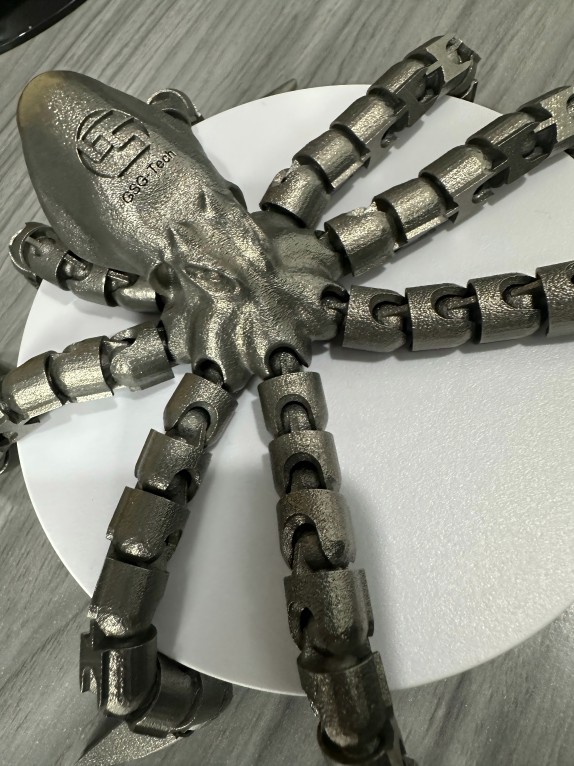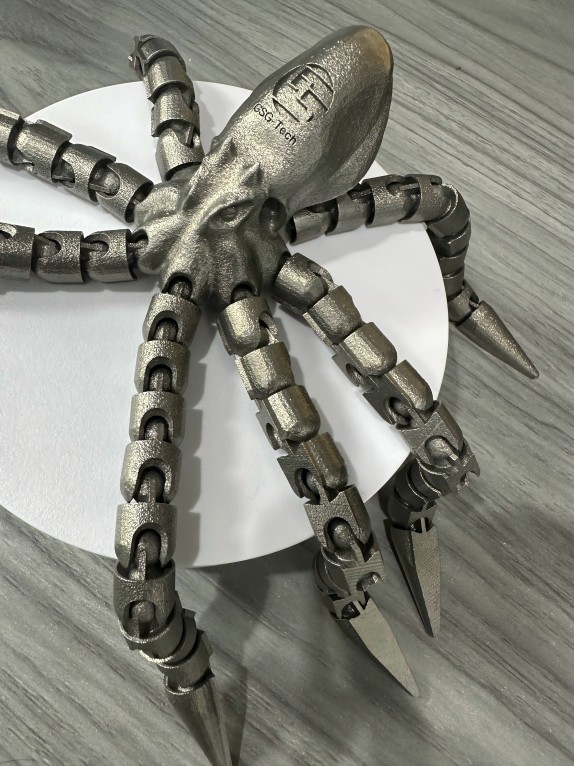Recently, we made a demonstration of metal 3D printing, and we completed it very successfully, so what is metal 3D printing? What are its advantages and disadvantages?
Metal 3D printing is an additive manufacturing technology that builds three-dimensional objects by adding metal materials layer by layer. Here is a detailed introduction to metal 3D printing:
Technical principle
Selective laser sintering (SLS) : The use of high energy laser beams to selectively melt and sinter metal powders, heating the powder material to a temperature slightly below its melting point, so that metallurgical bonds between powder particles are formed, thereby building the object layer by layer. In the printing process, a uniform layer of metal powder is first laid on the printing platform, and then the laser beam scans the powder according to the cross-section shape of the object, so that the scanned powder melts and solidifies together, after the completion of a layer of printing, the platform drops a certain distance, and then spread a new layer of powder, repeat the above process until the entire object is printed.
Selective Laser Melting (SLM) : Similar to SLS, but with higher laser energy, the metal powder can be completely melted to form a denser structure, higher density and better mechanical properties can be obtained, and the strength and accuracy of the printed metal parts are higher, close to or even exceed the parts produced by the traditional manufacturing process. It is suitable for manufacturing parts in aerospace, medical equipment and other fields which require high precision and performance.
Electron beam melting (EBM) : The use of electron beams as an energy source to melt metal powders. The electron beam has the characteristics of high energy density and high scanning speed, which can quickly melt metal powder and improve printing efficiency. Printing in a vacuum environment can avoid the reaction of metal materials with oxygen during the printing process, which is suitable for printing titanium alloy, nickel-based alloy and other metal materials sensitive to oxygen content, often used in aerospace, medical equipment and other high-end fields.
Metal material extrusion (ME) : Material extrusion based manufacturing method, through the extrusion head to extrude the metal material in the form of silk or paste, and at the same time to heat and cure, so as to achieve layer by layer accumulation molding. Compared with laser melting technology, the investment cost is lower, more flexible and convenient, especially suitable for early development in office environment and industrial environment.
Common materials
Titanium alloy: has the advantages of high strength, low density, good corrosion resistance and biocompatibility, widely used in aerospace, medical equipment, automotive and other fields, such as aircraft engine blades, artificial joints and other parts manufacturing.
Stainless steel: has good corrosion resistance, mechanical properties and processing properties, relatively low cost, is one of the commonly used materials in metal 3D printing, can be used to manufacture a variety of mechanical parts, tools, medical devices and so on.
Aluminum alloy: low density, high strength, good thermal conductivity, suitable for manufacturing parts with high weight requirements, such as automobile engine cylinder block, aerospace structural parts, etc.
Nickel-based alloy: with excellent high temperature strength, corrosion resistance and oxidation resistance, it is often used in the manufacture of high temperature components such as aircraft engines and gas turbines.
advantage
High degree of design freedom: The ability to achieve the manufacture of complex shapes and structures, such as lattice structures, topologically optimized structures, etc., which are difficult or impossible to achieve in traditional manufacturing processes, provides greater innovation space for product design, and can produce lighter, high-performance parts.
Reduce the number of parts: multiple parts can be integrated into a whole, reducing the connection and assembly process between parts, improve production efficiency, reduce costs, but also improve the reliability and stability of the product.
Rapid prototyping: It can produce a prototype of a product in a short time, speed up the product development cycle, reduce research and development costs, and help enterprises bring products to market faster.
Customized production: According to the individual needs of customers, unique products can be manufactured to meet the special requirements of different customers, suitable for medical implants, jewelry and other customized fields.
Limitation
Poor surface quality: The surface roughness of the printed metal parts is relatively high, and post-treatment is required, such as grinding, polishing, sandblasting, etc., to improve the surface finish, increasing the production cost and time.
Internal defects: there may be internal defects such as pores, unfused particles, and incomplete fusion during the printing process, which affect the mechanical properties of the parts, especially in the application of high load and cyclic load, it is necessary to reduce the occurrence of internal defects by optimizing the printing process parameters and adopting appropriate post-processing methods.
Material limitations: Although the types of metal 3D printing materials available are increasing, there are still certain material limitations compared with traditional manufacturing methods, and some high-performance metal materials are more difficult to print and cost is higher.
Cost issues: The cost of metal 3D printing equipment and materials is relatively high and the printing speed is slow, which is not as cost-effective as traditional manufacturing processes for large-scale production, and is currently mainly suitable for small batch, customized production and areas with high product performance and quality requirements.
Technical complexity: Metal 3D printing involves complex process parameters and process control, which requires professional operators and technical support, and requires high technical level and experience of operators.
Application field
Aerospace: Used to manufacture aero-engine blades, turbine discs, wing structures, satellite parts, etc., which can reduce the weight of parts, improve fuel efficiency, reduce production costs, and ensure the high performance and reliability of parts.
Automobile: Manufacture automobile engine cylinder block, transmission shell, lightweight structural parts, etc., to achieve lightweight design of automobiles, improve fuel economy and performance.
Medical: The production of medical devices, artificial joints, dental orthotics, implantable medical devices, etc., according to the individual differences of patients customized manufacturing, improve the suitability of medical devices and treatment effects.
Mold manufacturing: Manufacturing injection molds, die casting molds, etc., shorten the mold manufacturing cycle, reduce costs, improve the accuracy and complexity of the mold.
Electronics: Manufacture radiators, shells, circuit boards of electronic equipment, etc., to achieve integrated manufacturing of complex structures, improve the performance and heat dissipation effect of electronic equipment.
Jewelry: According to the designer’s creativity and customer needs, a variety of unique jewelry can be manufactured to improve production efficiency and product personalization.
Post time: Nov-22-2024


